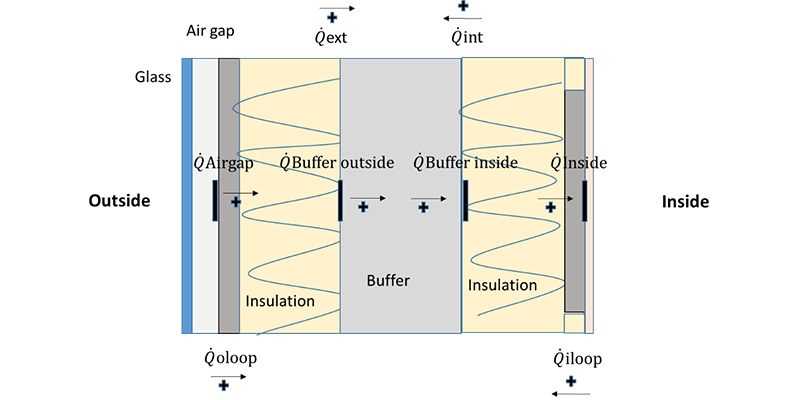Downloads
DOI:
https://doi.org/10.7480/jfde.2018.3.2564Keywords:
adaptive facades, double skin facades, adaptive insulation, performance metrics, experimental characterisationAbstract
Traditional façade characterisation metrics such as U-value and g-value are of limited value in the design process of buildings with adaptive façades. This issue is particularly important for adaptive façade components that have the capability of controlling thermal energy storage in the construction thermal mass. Building performance simulations can help to analyse the performance of buildings with adaptive façades, but such studies usually only provide information about the energy and comfort performance at room level. Consequently, there is a need for development and testing of new façade-level performance metrics that can be used to compare the performance of different adaptive façade components. This paper presents experiences and lessons learned from four European R&D projects that have introduced novel metrics to capture the dynamic performance of adaptive opaque façades. Characteristics of the different metrics are described, and their similarities and differences are compared and contrasted. The paper highlights the main benefits of metrics that can capture dynamic effects, and concludes by providing directions for future work.
How to Cite
Published
Issue
Section
License
Copyright (c) 2018 Lorenza Bianco, Ylenia Cascone, Stefano Avesani, Pascal Vullo, Timea Bejat, Stefan Koenders, Roel C.G.M Loonen, Francesco Goia, Valentina Serra, Fabio Favoino

This work is licensed under a Creative Commons Attribution 4.0 International License.
Authors or their institutions retain copyright to their publications without restrictions.
References
Aldawoud, A. (2013). Conventional fixed shading devices in comparison to an electrochromic glazing system in hot, dry climate. Energy and Buildings, 59, pp.104-110.
Bianco, L. (2014). Involucri trasparenti innovativi. Modellazione e sperimentazione su componenti dinamici e sistemi di facciata attivi. [Innovative transparent envelopes. Modelling and experimentation on dynamic components in active façade systems]. (Doctoral Thesis), Politecnico di Torino, Torino, Italy. doi:10.6092/polito/porto/2548139
Bianco, L., Goia, F., Serra, V., & Zinzi, M. (2015). Thermal and Optical Properties of a Thermotropic Glass Pane: Laboratory and In-Field Characterization. Energy Procedia 78, pp.116–121. doi:10.1016/j.egypro.2015.11.124
Bianco, L., Cascone, Y., Goia, F., Perino, M., & Serra, V. (2017a). Responsive glazing systems: Characterisation methods and winter performance. Solar Energy 155, pp. 372–387. doi:10.1016/j.solener.2017.06.029
Bianco L., Cascone Y., Goia F., Perino M., & Serra V. (2017b). Responsive glazing systems: Characterisation methods, summer performance and implications on thermal comfort. Solar Energy 158, pp.819-836. doi: doi.org/10.1016/j.solener.2017.09.050
Corgnati S.P., Perino M., & Serra V. (2007). Experimental assessment of the performance of an active transparent façade during actual operating conditions. Solar Energy 81:8, pp.993-1013.
EN ISO (2007). ISO 13789:2007. Thermal performance of buildings -- Transmission and ventilation heat transfer coefficients -- Calculation method
DiMaio, F., & Van Passen, A.H.C. (2001). Modelling the air infiltrations in the second skin façade. In: Proceedings of IAQVEC 2001 – The 4th International Conference on Indoor Air Quality, Ventilation and Energy Conservation in Buildings, 2-5 October 2001, Changsha (China), pp.873-880.
Favoino F., Goia F., Perino M., & Serra V. (2013). Experimental assessment of the energy performance of an advanced responsive multifunctional façade module, Energy and Buildings, Available online 19 September 2013, ISSN 0378-7788, http://dx.doi.org/10.1016/j.enbuild.2013.08.066
Favoino F., Goia F., Perino M., & Serra V. (2016). Experimental analysis of the energy performance of an Active, RESponsive and Solar (ACTRESS) façade module, Solar Energy 133, doi: 10.1016/j.solener.2016.03.044.
Favoino, F., Jin, Q., & Overend, M. (2017). Design and control optimisation of adaptive insulation systems for office buildings. Part 1: Adaptive technologies and simulation framework, Energy 127, pp.301-309. Retrieved from https://doi.org/10.1016/j.energy.2017.03.083.
Favoino, F., Overend, M., & Jin, Q., (2015). The optimal thermo-optical properties and energy saving potential of adaptive glazing technologies. Applied Energy 156, pp.1–15.
Fiorito, F., Sauchelli, M., Arroyo, D., Pesenti, M., Imperadori, M., Masera, G., & Ranzi, G. (2016). Shape morphing solar shadings: A review. Renewable and Sustainable Energy Reviews, vol. 55(C), pp. 863-884. New York: Elsevier.
Goia, F., Perino, M., & Serra, V. (2013). Improving thermal comfort conditions by means of PCM glazing systems. Energy and Buildings 60, pp.442–452. doi: 10.1016/j.enbuild.2013.01.029
Goia, F,. Perino, M., & Serra, V. (2014). Experimental analysis of the energy performance of a full-scale PCM glazing prototype. Solar Energy 100, pp.217–233. doi: 10.1016/j.solener.2013.12.002
Goia, F., & Serra, V., (2018). Analysis of a non-calorimetric method for assessment of in-situ thermal transmittance and solar factor of glazed systems. Solar Energy 166, pp.458–471. doi: 10.1016/j.solener.2018.03.058
Jin, Q., Favoino, F., & Overend, M., (2017). Design and control optimisation of adaptive insulation systems for office buildings. Part 2: A parametric study for a temperate climate. Energy 127, pp.634–649. doi:10.1016/j.energy.2017.03.096
Koenders, S., Loonen, R.C.G.M., & Hensen, J.L.M. (2018). Investigating the potential of a closed-loop dynamic insulation system for opaque building elements. Energy and Buildings 173, pp.409-427. doi: 10.1016/j.enbuild.2018.05.051
Loonen R.C.G.M., Favoino F., Hensen J.L.M., & Overend, M. (2017). Review of current status, requirements and opportunities for building performance simulation of adaptive façades, Journal of Building Performance Simulation, doi:10.1080/19401493.2016.1152303
Loonen, R.C.G.M., Singaravel, S., Trčka, M., Cóstola, D., & Hensen, J.L.M., (2014). Simulation-based support for product development of innovative building envelope components. Automation in Construction 45. doi:10.1016/j.autcon.2014.05.008
Loonen, R.C.G.M., Trčka, M., Cóstola, D., & Hensen, J.L.M., (2013). Climate adaptive building shells: State-of-the-art and future challenges. Renewable and Sustainable Energy Reviews 25, pp.483–493. doi:10.1016/j.rser.2013.04.016
